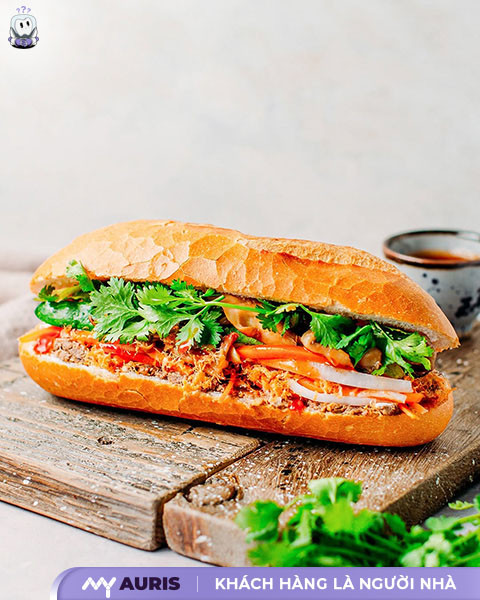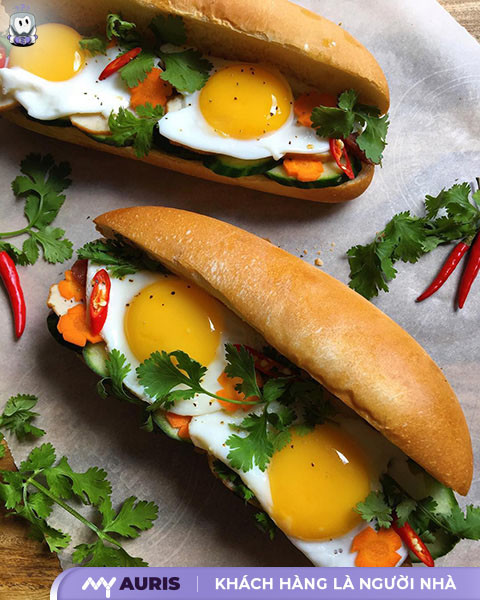Banh mi is a familiar dish for breakfast and a staple of Vietnamese street food. Determining how many calories a banh mi contains is an important question for those pursuing a healthy diet. Understanding this number helps you control your energy intake, a key factor in managing weight and overall health.
Nutritional Components in Banh Mi
Reference nutritional breakdown for 100g of white bread:
| Nutrient | Estimated Content | Unit |
| Energy (Calories) | 265 | kcal |
| Carbohydrate | 50 | g |
| Sugar | 5 | g |
| Fiber | 2.7 | g |
| Protein | 9 | g |
| Fat | 3.2 | g |
| Sodium | 491 | mg |

How many calories in a banh mi?
A traditional Vietnamese banh mi, weighing about 90g – 100g, typically provides an average of 230 – 250 calories, whether it’s white bread or rye bread. This is the common calorie count for a plain banh mi, suitable for those who are controlling their energy intake.
If you enjoy a banh mi with meat, the calorie count can go up to 500 calories. This is the total energy from the plain banh mi plus the fillings, including cucumber, meat, sauce, pate, etc. This dish is not only delicious but also provides essential protein and fiber for the body.
Banh mi with fried egg (bánh mì ốp la) or egg banh mi is also a popular choice. With 1 fried egg (~80 calories) combined with banh mi, you will consume about 330 calories. If you use 2 eggs, the calorie count can go up to 410 calories.
A banh mi with fish cake (chả cá) typically contains about 450 calories, including fried fish cake, cucumber, chili sauce, and the crispy, aromatic banh mi – a familiar dish for Vietnamese people from early morning until late at night.
Additionally:
- An average slice of sandwich bread is about 250 calories.
- 1 slice of multi-grain bread contains about 150 calories.
- 1 slice of rye bread (bánh mì đen) ranges from 80 – 100 calories, depending on its ingredients and weight.
Note: The calorie counts for banh mi mentioned above are approximate for reference. Actual values may vary depending on the preparation method and specific ingredients used at different locations.

How many calories in an egg banh mi?
Many people wonder about the calorie count of an egg banh mi, especially since it’s a popular and convenient breakfast item. In reality, the calorie content of an egg banh mi depends on its individual components, such as the regular banh mi roll, the egg, and other accompanying ingredients.
- Regular banh mi roll: approximately 230 calories/roll (depending on size).
- Chicken egg calories: around 155 calories/egg.
- Pate calories: approximately 319.1 calories/100g (typically about 1 slice is used).
- Cooking oil, spices, cilantro, cucumber, lettuce, chopped green onions: contribute to the flavor, and also add a certain amount of calories.
In summary, a banh mi with egg and pate will provide about 400 calories – this is considered an appropriate average calorie count for an energetic breakfast. If you only have banh mi with fried egg (ốp la) without pate, vegetables, or sauce, the calorie count can decrease to about 330 calories per roll.
How many calories in sweet bread?
Sweet bread is a popular snack thanks to its delicious and easy-to-eat flavor. The main ingredients of sweet bread typically include wheat flour, eggs, and milk, which are rich in nutrients like protein, fat, and fiber, offering positive health effects if consumed in moderation.
According to nutrition experts, the calorie count of sweet bread can vary by type. On average, a plain sweet bun provides about 200 – 300 calories, while sweet bread with fillings (such as cheese, red bean, cold cuts, etc.) can contain up to 300 – 400 calories.
Compared to many other foods, this considerable calorie level can easily lead you to exceed your energy limit if consumed excessively. However, with its rich nutrient content, sweet bread can still be a good choice when you need a quick energy boost, provided you control your portion sizes appropriately.

Does eating banh mi cause weight gain?
Eating banh mi is a quick and convenient meal option that provides a full range of nutrients from meat, vegetables, and carbohydrates. A typical Vietnamese banh mi with meat contains around 500 calories – a figure that is not too high compared to the average daily calorie intake recommended for adults, which is about 2000 calories.
Therefore, if you only eat one banh mi per meal and maintain a reasonable diet throughout the day, there’s no need to worry about weight gain or impacting your weight. The key is to control portions and maintain a healthy lifestyle.
The benefits that banh mi brings
The truth is, when understood correctly and chosen wisely, banh mi offers many valuable benefits. It’s not just a convenient dish. Banh mi, especially types made from whole grains, is a powerful tool to help you build a healthy diet. Let’s explore the unexpected benefits that banh mi can bring to your health:
The body needs energy to function, and carbohydrates are the main source. Banh mi is a source of complex carbohydrates, especially whole wheat bread or barley bread.
Fiber is an important nutrient that is often overlooked. Types of bread such as whole wheat bread, rye bread, and oat bread contain a significant amount of fiber.
Effective weight loss might sound counterintuitive, but eating bread correctly can actually help you lose and maintain weight. The key lies in choosing the right type of bread and controlling portion sizes.
A source of essential Vitamins and Minerals. Vitamins such as B1 (thiamine), B2 (riboflavin), and B3 (niacin) play crucial roles in converting energy from food. Whole grain bread provides iron, essential for blood formation; magnesium, important for muscle and nerve function; and selenium, a powerful antioxidant.
What kind of bread to eat for weight loss?
Applying these principles will transform bread from a concern into a powerful ally on your health and weight loss journey. Below are 8 specific types of bread recommended by experts.
Ezekiel Bread
Ezekiel bread is made from sprouted grains and legumes, free of flour and sugar. Thanks to its rich content of complete protein and fiber, it effectively supports weight loss, stabilizes blood sugar, and promotes a feeling of fullness. Each slice contains only about 80 calories, making it suitable for breakfast or a snack. It is often sold in the freezer section of large supermarkets or health food stores.
Rye Bread
Rye bread is a healthy choice due to its richness in soluble fiber, which helps keep you full longer and supports calorie control, making it suitable for a weight loss diet. Opt for 100% rye bread for the best results. One slice contains about 65–80 calories and should be consumed for breakfast with fatty, savory items like salmon, avocado, or pate.
Whole Wheat Bread
Whole wheat bread retains the entire bran, germ, and endosperm of the wheat kernel, providing fiber, B vitamins, iron, and magnesium. Thanks to its high fiber content, it supports weight loss and maintains stable energy levels. Each slice contains about 70–90 calories, suitable for breakfast or a light meal. When choosing, ensure the label states “100% whole wheat.”
Flaxseed Bread
Flaxseed bread is rich in omega-3s, fiber, and antioxidants, effectively supporting weight loss by promoting fullness and improving metabolism. It has a nutty flavor and pairs well with many dishes. Choose varieties where flaxseed is a primary ingredient or make it yourself at home to ensure nutritional quality.
Pita Bread
Pita bread is a Middle Eastern flatbread that puffs up and becomes hollow when baked, making it suitable for stuffing. The whole wheat version supports weight loss due to its lower calorie count (150–170 calories/piece), high fiber content, and better carbohydrate control compared to sandwich bread. It can be used for wraps or baked until crispy for dipping, offering a healthy alternative to french fries.
Oat Bread
Oat bread, made from whole oats and whole wheat flour, contains abundant soluble beta-glucan fiber, which helps lower bad cholesterol and control blood sugar. The calorie content in oat bread is generally comparable to whole wheat bread, at around 80 calories per slice.
It promotes a feeling of fullness, supports weight loss, and provides stable energy. Choose varieties with low sugar content, where oats and whole wheat flour are the main ingredients.
Whole Grain Bread
Whole grain bread is an enhanced version of whole wheat bread, combining various grains and seeds like oats, sunflower seeds, pumpkin seeds, etc., to boost nutrition. It’s rich in fiber, protein, and healthy fats, supporting weight loss and cardiovascular health. Its rich flavor makes it suitable as a substitute for regular bread in many dishes.
Barley Bread
Barley bread, made from barley flour, has a low glycemic index, which helps control blood sugar and effectively supports weight loss. Rich in fiber and beta-glucan, it promotes fullness, stabilizes insulin, and boosts metabolism. This bread has a nutty, slightly sweet taste, suitable for pre-workout meals and can be combined with lean protein and green vegetables to enhance its nutritional effectiveness.
Notes when eating bread to avoid weight gain
Look for whole wheat bread, rye bread, or oat bread. These types of bread are made from the entire wheat kernel, retaining the bran and germ rich in fiber, B vitamins, and minerals. The fiber in whole grains slows down digestion, helping you feel fuller for longer, stabilizing blood sugar, and reducing cravings for snacks. This is a top choice for weight loss and weight maintenance.
Traditional white bread is made from refined flour, which has almost all fiber and nutrients removed. It has a high glycemic index (GI), causing blood sugar to rise quickly after eating and then drop sharply, leading to feelings of hunger and fatigue. This type of carbohydrate is easily converted into stored fat if not fully utilized.
When buying packaged bread, make it a habit to read the label. The first ingredient on the list should be whole wheat flour or whole grains. Avoid products with sugar, high-fructose corn syrup, or hydrogenated oils in the ingredient list. Some varieties like Ezekiel bread (made from sprouted grains) or flaxseed bread are excellent choices, providing additional protein and healthy fats. Understanding the origin and main ingredients is key to controlling the energy from bread.
Breakfast is the ideal time. Eating bread in the morning provides complex carbohydrates, releasing energy slowly to help you function effectively throughout the workday. Lunch is also a good option.
Limit eating bread for dinner or close to bedtime. At these times, the body is less active, and energy from carbohydrates that is not fully used tends to be stored as excess fat.





